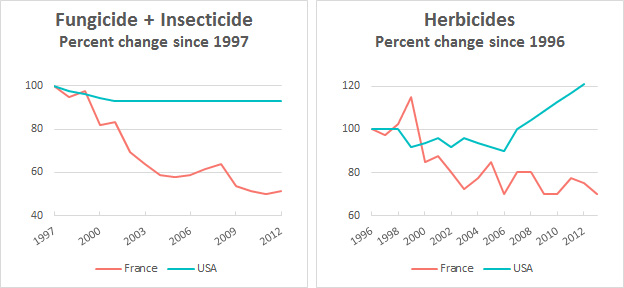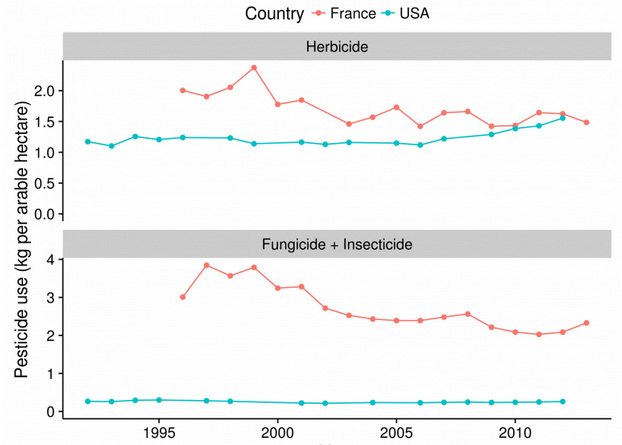

| Online: | |
| Visits: | |
| Stories: |

| Story Views | |
| Now: | |
| Last Hour: | |
| Last 24 Hours: | |
| Total: | |
GMO Statistics Part 43. How to Mislead With Statistics: GMO Crops Edition | Mother Jones
The New York Times recently had a front page story supposedly telling all about the GMO based USA is doing badly with herbicide and synthetic pesticide use in farming as compared to non-GMO France.
A key feature was claims about percentage changes in synthetic pesticide use in farms.
.
US professor A. Kniss' graphs (just republished at Mother Jones) show how The Times' version of those claims looks in a visual format.
 |
| How to mislead — judicious use of starting point, country and percentage values |
The graphs, at face value put US Agriculture in a bad position as it seems French usage it getting better while USA is getting worse, in terms of potential environmental impact of synthetic chemicals.
But when the data are plotted on a fair basis by showing of abolute amount used per area of land, something the NYT failed to show, a different story emerges:
 |
| Fairer ways of making inter-country comparisons — how much stuff per acre? |
In this graphical presentation, non-GMO France is only recently catching up with the better performing GMO crop using USA. But that aspect of the numbers didn't match the Times' forced narrative.
(Follow the links back to see other ways NYT got this major story wrong.)
@How to Mislead With Statistics: GMO Crops Edition | Mother Jones:
The original NYT front-pager that started this pesticide usage discussion also got involved in discussions about crop yield improvement. These discussions also missed their target.
It's worth noting that criticisms of GM technology's lack of contribution to yield improvement have been going on for several years. See an earlier GMO Pundit post on crop yield here:
The Pundit thus finds it easy to guess where The Times got the missing yield benefit part of their story line from.
Source: http://gmopundit.blogspot.com/2016/11/gmo-statistics-part-43-how-to-mislead.html




Well, would you like to clarify the term arable land?
Being a different kind of pundit, some of this may also hint at some more bullshit being peddled:
http://www.tradingeconomics.com/france/arable-land-percent-of-land-area-wb-data.html
http://www.tradingeconomics.com/united-states/arable-land-percent-of-land-area-wb-data.html